Key takeaways:
- PID control optimizes system performance by balancing three components: Proportional (P), Integral (I), and Derivative (D), each addressing different aspects of error correction.
- Tuning PID parameters requires careful observation and experimentation, with various methods like Ziegler-Nichols, trial-and-error, and model-based approaches enhancing performance in real-time applications.
- Future trends in PID technology include data-driven optimization, adaptive controllers that adjust to system behavior, and integration with IoT for enhanced remote monitoring and control capabilities.
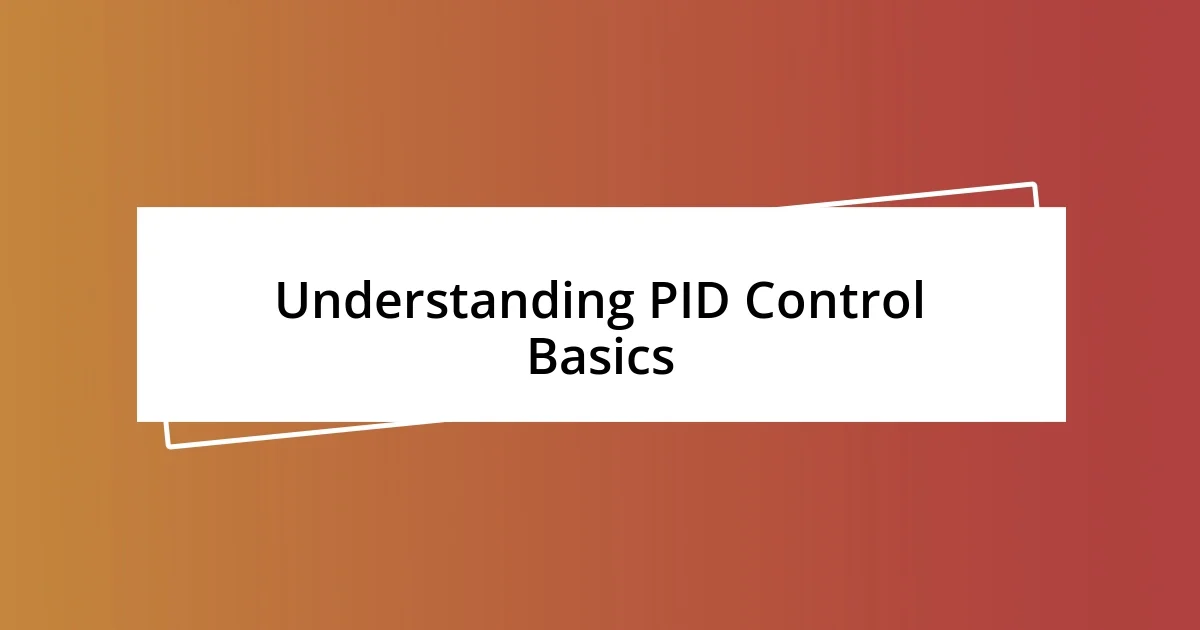
Understanding PID Control Basics
PID control, which stands for Proportional-Integral-Derivative control, is a widely used feedback loop mechanism in industrial control systems. I remember the first time I encountered PID controllers in a robotics course; I was fascinated by how adjusting a simple set of parameters could dramatically improve a robot’s performance. It made me wonder, how could something so technical feel so intuitive?
At its core, a PID controller strives to minimize the difference between a desired set point and the actual process variable. This balance is achieved by adjusting control outputs based on three principles: the proportional term reacts to the current error, the integral term addresses accumulated past errors, and the derivative term predicts future errors based on the rate of change. It’s like having a strategic partner in a game who can anticipate your moves and make adjustments to help you win.
When I think about the power of PID control, I realize it’s not just about tuning parameters; it’s about understanding system dynamics. Have you ever tried baking a cake? The temperature and timing must be just right for the perfect outcome. Similarly, in PID control, finding the right balance between the P, I, and D factors is key to achieving a smooth response and minimizing oscillations. This connection between everyday experiences and PID concepts can really deepen our understanding of control systems.
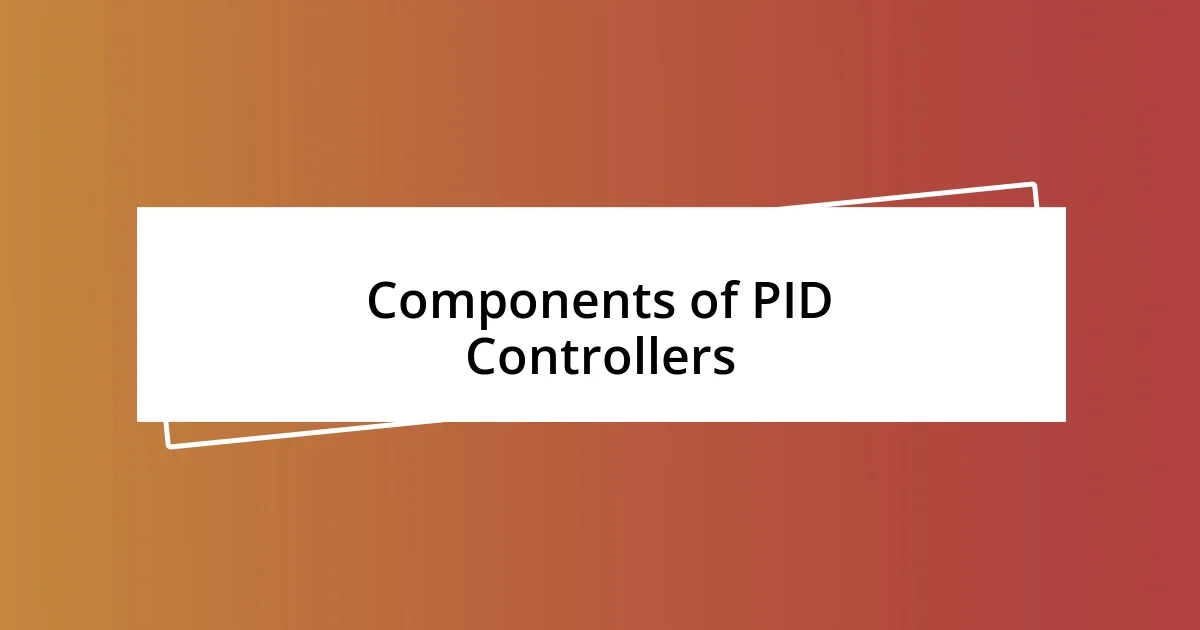
Components of PID Controllers
Understanding the components of a PID controller is crucial for anyone aiming to grasp how it operates effectively. Each component has a unique role, working together to refine system performance. Personally, I’ve found that visualizing these terms through real-world scenarios makes them easier to digest. For example, I often liken the integral component to keeping a meticulous diary. Just as you reflect on past entries to improve your future actions, the integral term sums past errors to enable correction over time.
Here are the key components of PID controllers:
- Proportional (P): Addresses the current error, providing an immediate response proportional to the error magnitude.
- Integral (I): Compensates for past errors by accumulating them over time, ensuring that any steady-state error is eliminated.
- Derivative (D): Forecasts future errors by considering the rate of change of the error, helping to dampen the system response and reduce overshoot.
Reflecting on my experience with an automated temperature control system, I realized how these components play out in practice. When I increased the proportional gain, there was a noticeable response — but I also faced the dreaded overshoot. That’s when I truly appreciated the balancing act between these components, making me more invested in mastering the nuances of PID tuning.
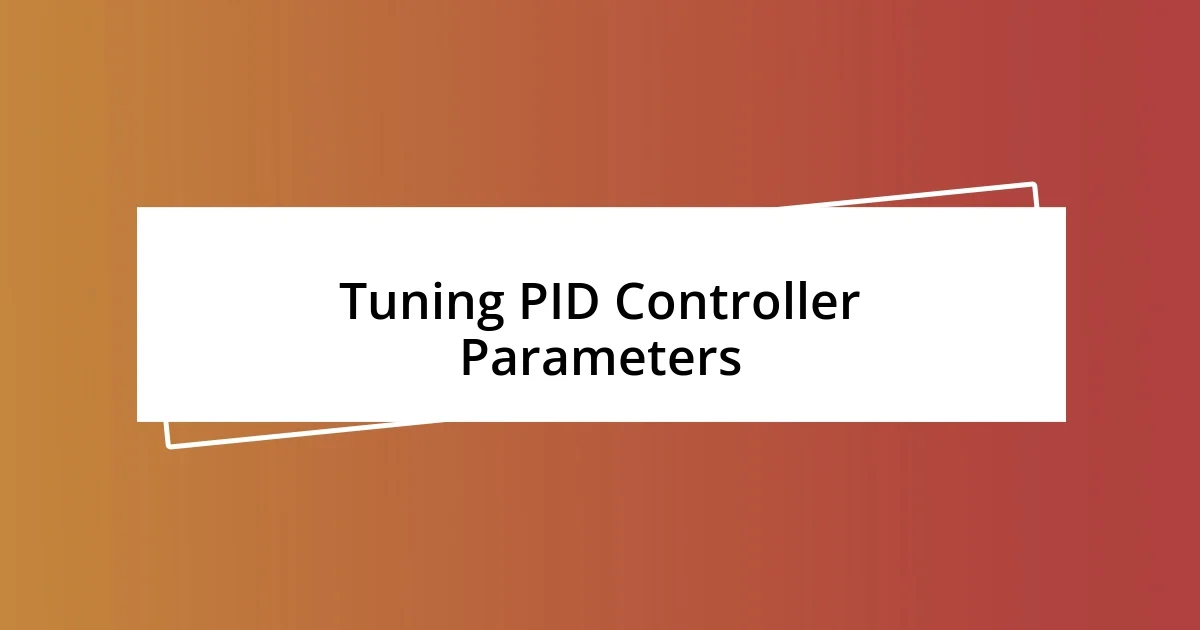
Tuning PID Controller Parameters
Tuning the parameters of a PID controller can feel like a delicate dance, and I’ve certainly felt the pressure while working on it. Each parameter—proportional, integral, and derivative—requires careful consideration. For instance, I remember tuning a PID controller for a drone’s flight stability. Adjusting the proportional gain made a significant difference in responsiveness, but too much caused the drone to wobble uncontrollably. Finding that sweet spot was both frustrating and rewarding.
As I continued experimenting, I realized that the integral term was crucial for eliminating steady-state errors. During one project with a temperature control system in a lab, I noticed that even when I reached the setpoint, the temperature wouldn’t stay constant. It turned out the integral gain needed fine-tuning to address the offset. What a relief it was to finally see the temperature stabilize after those adjustments!
The derivative parameter can sometimes feel like an afterthought, but don’t underestimate its impact. In my experience calibrating a conveyor belt system, increasing the derivative gain helped reduce oscillations, making the system much smoother. It’s fascinating how a minor adjustment can yield profound changes in performance, like tuning the strings of a musical instrument for a perfect harmony.
| Parameter | Effect |
|---|---|
| Proportional (P) | Affects reaction to current error; increases responsiveness |
| Integral (I) | Eliminates steady-state error but can introduce overshoot |
| Derivative (D) | Predicts future errors; reduces oscillation and overshoot |
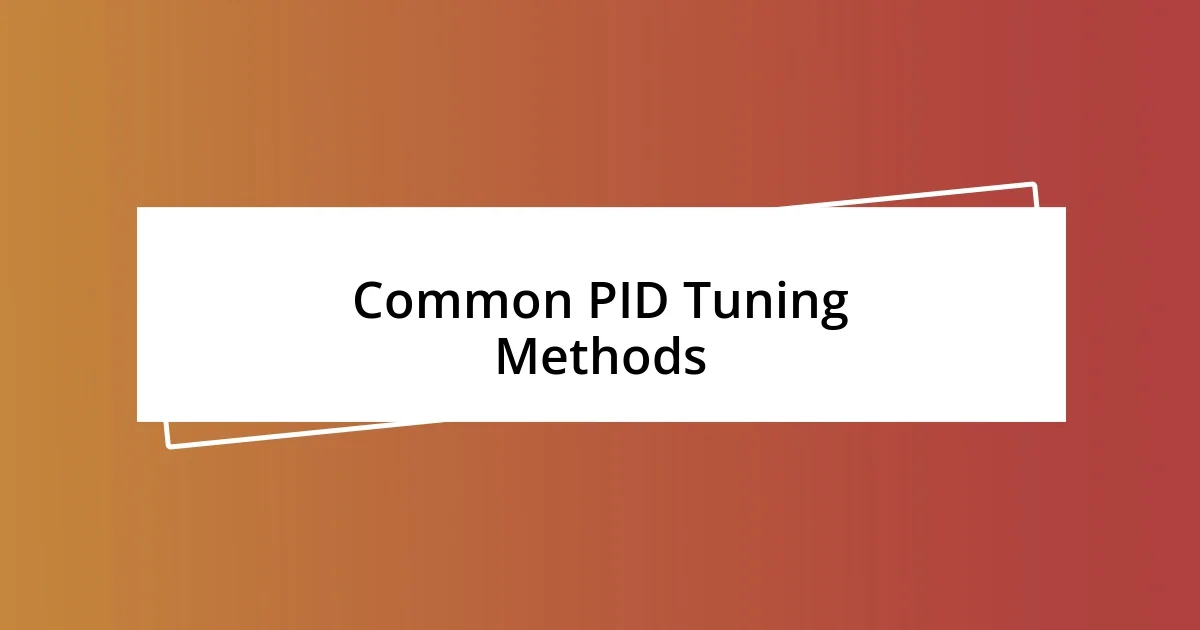
Common PID Tuning Methods
Tuning PID controllers can indeed feel like piecing together a puzzle, each method offering its own insights. One common tuning method is the Ziegler-Nichols approach, which I’ve used in several projects, including a robotic arm I developed. I set the integral and derivative gains to zero, then increased the proportional gain until the system oscillated consistently. This helped me identify critical gain values, enabling me to get real-time feedback on my adjustments. It was a bit nerve-wracking but also exhilarating to witness the rapid changes.
Another method I’ve experimented with is the trial-and-error approach. I remember working on a temperature control system for a fermentation process. I started with conservative gains and made incremental adjustments based on the system’s response. Each tuning session felt like a science experiment where the results didn’t always go as planned. Would this be too much? Would it undershoot? It taught me the importance of patience and careful observation, aligning well with my methodology.
For systems requiring higher precision, the model-based tuning method has been an eye-opener for me. I once applied this technique when developing a climate control solution for a greenhouse. By creating a mathematical model of the system, I gained a deeper understanding of the dynamics at play. Adjusting the PID parameters using simulations allowed me to foresee potential issues before they occurred in the live environment. It was incredibly satisfying to see the theory translate into practice, bringing a harmonious balance to the complex interactions of the greenhouse ecosystem.
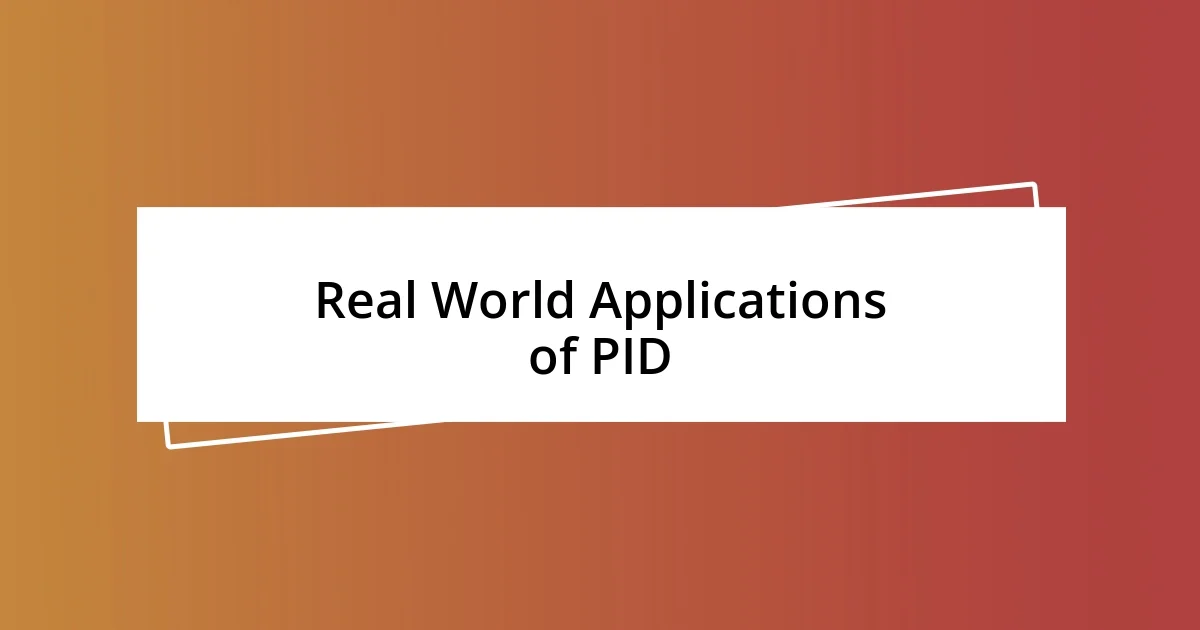
Real World Applications of PID
When it comes to real-world applications of PID controllers, I’ve seen their transformative power in various industries. Take the automotive sector, for instance; implementing PID controllers in engine management systems has significantly optimized fuel efficiency and reduced emissions. I remember first observing this during a project with an electric vehicle prototype. It was astonishing how the controller adjusted the throttle in real-time, improving acceleration while maintaining stability. Watching it all come together was genuinely exciting.
In building automation, I often find PID controllers regulating temperature in HVAC systems. One unforgettable moment was during a summer heat wave when our office’s climate control system struggled to maintain a comfortable environment. After some fine-tuning, the PID controller began dynamically adjusting the airflow and temperature settings, keeping us all cool and focused. Have you ever experienced a perfectly climate-controlled space? The difference is often taken for granted until you see the technology behind it in action.
I’ve also encountered PID controllers in the realm of robotics, specifically for robotic arms used in manufacturing. During a project where precision was crucial, I watched the robot manipulate components with incredible accuracy thanks to fine-tuned PID parameters. It almost felt like a choreography between man and machine, with the controller ensuring every movement was smooth and deliberate. Isn’t it amazing how a well-implemented PID controller can turn a mechanical system into something that feels alive?
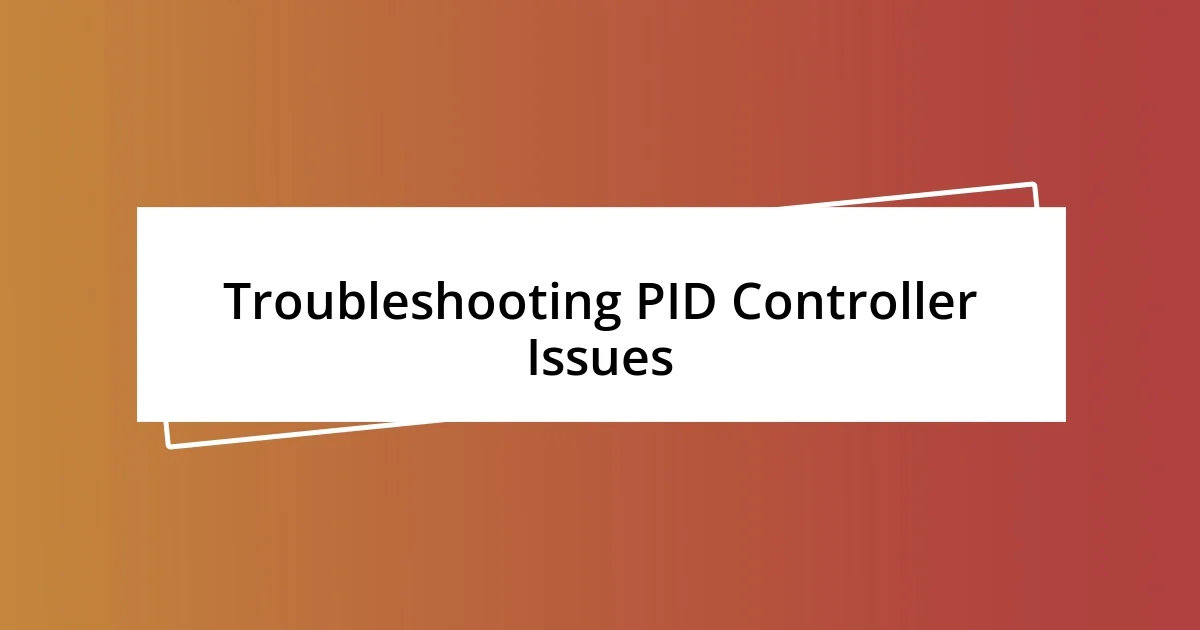
Troubleshooting PID Controller Issues
Troubleshooting PID controller issues can often feel like diving into a maze, especially when unexpected behaviors arise. I recall a situation where I faced oscillations that seemed to come from nowhere. After checking my proportional gain, I realized it was set too high. The moment I dialed it back, the system’s stability improved almost instantly—it’s a vivid reminder of how precise these controllers must be.
Sometimes, I’ve found that incorrect integral settings are the culprits behind persistent offset errors. I once spent several hours fine-tuning a PID controller for a pressure control system when I noticed an ongoing deviation from the setpoint. Adjusting the integral gain surprisingly resolved the issue with minimal tweaks. Isn’t it fascinating how a simple change can yield such profound results?
Moreover, I’ve encountered situations where external factors, like noise or fluctuating environmental conditions, interfered with the PID controller’s performance. During an experiment with a flow control system, I noticed erratic output signals. By adding filtering to the feedback loop, I managed to smooth out the disturbances. Have you ever realized that sometimes the environment has a way of challenging our carefully laid plans? It highlighted the need for flexibility in approach—a lesson I carry with me in all my projects.

Future Trends in PID Technology
As I look toward the future of PID technology, it’s clear that data-driven approaches are gaining traction. I remember reading about how organizations are increasingly leveraging machine learning to enhance PID controllers’ performance. By analyzing historical data, they can fine-tune parameters dynamically, adapting to changing conditions in real time. Isn’t it incredible to think how algorithms might someday predict the optimal settings before a scenario even unfolds?
Another exciting trend I see is the rise of adaptive PID controllers. These systems can adjust their parameters based on system behavior, which I find particularly fascinating. During a recent project, I encountered a traditional PID setup that struggled under varying load conditions. Can you imagine how much easier that project would have been if the controller could learn and adapt? This evolution promises to open doors to improved efficiency and less manual intervention.
Moreover, we’re starting to see the integration of IoT (Internet of Things) with PID controllers. When I first experimented with connecting a PID controller to the cloud, I was blown away by the remote monitoring capabilities. It allowed real-time adjustments and insights I previously couldn’t have imagined. Isn’t it exciting to think about the potential this technology has to transform our everyday experiences and industrial processes? As we embrace these advancements, the possibilities seem endless.














